So Beautiful Stapelia Flower
Stapelia: The Unique and Fascinating “Carrion Flowers”
The Stapelia genus, a collection of unique flowering succulents often known as “carrion flowers” or “starfish flowers,” is one of nature's most curious plant genera. Native to South Africa and other parts of Southern Africa, Stapelias are celebrated for their eye-catching, star-shaped flowers and their unusual aroma. While their captivating flowers make them a favorite among succulent enthusiasts, their odor—resembling that of decaying flesh—makes them particularly intriguing. This post dives into the fascinating world of Stapelia, exploring its appearance, lifecycle, care requirements, and role in nature.
What Are Stapelias?
Stapelias belong to the Apocynaceae family, which includes well-known plants like milkweeds and oleanders. Named after Dutch botanist Johannes van Stapel, Stapelias are small, low-growing succulent plants with fleshy stems. While they may initially seem unassuming, their flowers are anything but ordinary. Each flower, which can reach sizes as large as 12 inches across, resembles a starfish with vibrant colors, from yellow and maroon to deep purple. The flowers are often covered in fine hairs and intricate patterns, mimicking the appearance of decaying flesh.
The infamous smell associated with Stapelia flowers is a result of the plant's evolutionary adaptation. While most plants attract pollinators with sweet scents, Stapelias emit a foul odor to lure flies, their primary pollinators, mimicking the scent of rotting meat. This "olfactory deception" attracts flies, which in turn aid in pollination, allowing the plant to reproduce.
Stapelia Varieties
There are over 50 species of Stapelia, each with distinct characteristics and flowering habits. Here are a few of the most popular species:
Stapelia gigantea: Known for producing some of the largest flowers in the genus, Stapelia gigantea is a true showstopper. Its flowers can span up to 14 inches and have a pale yellow color, often with maroon stripes.
Stapelia hirsuta: This species is particularly striking due to its hairy flowers, which have a velvet-like texture. The hairs help to scatter sunlight, giving the plant a unique, shimmering appearance.
Stapelia grandiflora: As its name suggests, this Stapelia species has large flowers, although they are slightly smaller than those of Stapelia gigantea. The blooms are typically deep red with pronounced hairs, which only add to their lifelike appearance.




